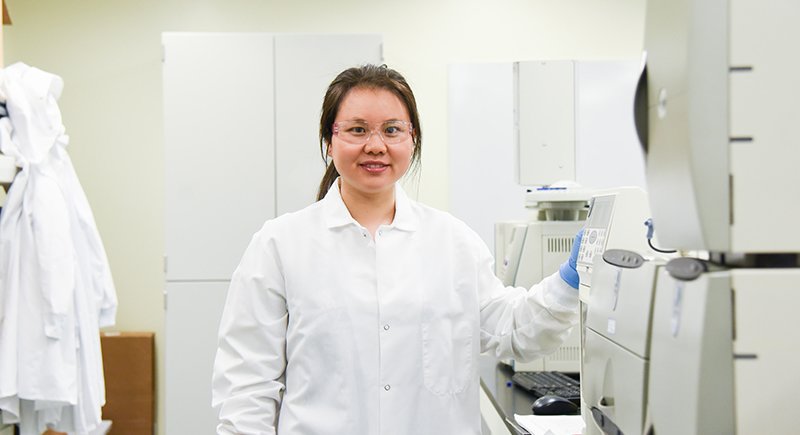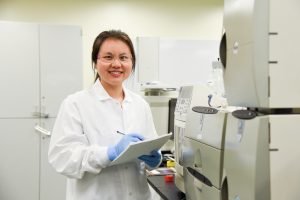
March 24, 2017 New way to characterize cellulose, advance bioproducts
By Maegan Murray, WSU Tri-Cities
 RICHLAND, Wash. – Researchers at Washington State University Tri-Cities and Pacific Northwest National Laboratory have found a new way to define the molecular structure of cellulose, which could lead to cheaper and more efficient ways to make a variety of crucial bioproducts.
RICHLAND, Wash. – Researchers at Washington State University Tri-Cities and Pacific Northwest National Laboratory have found a new way to define the molecular structure of cellulose, which could lead to cheaper and more efficient ways to make a variety of crucial bioproducts.
For the first time, researchers revealed the differences between the surface layers and the crystalline core of cellulose by combining spectroscopy processes that use infrared and visible laser beams to analyze the structure of molecular components. The findings appear this month in Scientific Reports, an online open-access journal produced by the Nature Publishing Group (http://www.nature.com/articles/srep44319).
The spectroscopy processes are known as Total Internal Reflection Sum Frequency Generation Vibrational Spectroscopy (TIR-SFG-VS) and conventional SFG-VS.
Making biofuels, bioproducts cost-competitive
Bin Yang, co-author and WSU Tri-Cities associate professor of biological systems engineering, said cellulose is one of the most abundant organic compounds on Earth. Understanding the cellulosic biomass recalcitrance, or resistance to degradation, at the molecular level is a key step toward overcoming the fundamental barrier to making cellulosic biofuels cost-competitive, he said.
“Cellulose is commonly known as a product that is difficult to break down and convert into other useful products,” said co-author Hongfei Wang, former chief scientist in the physical sciences division at PNNL and current professor of chemistry at Fudan University in Shanghai. “Using our nonlinear vibrational spectroscopic technique, we can resolve some questions associated with the recalcitrance of cellulosic biomass and, in turn, more efficiently convert the product into a usable commodity.”
Yang said that although plant cell walls are complex and dynamic, recent advances in analytical chemistry and genomics have substantially enhanced understanding of cellulosic biomass recalcitrance while simultaneously highlighting the remaining knowledge gaps.
Understanding structure opens industrial possibilities
“This discovery is significant because it not only challenges the traditional understanding of cellulose materials, it provides further insight into the surface and bulk chemistry of cellulosic fibers, building on a novel spectroscopic tool to characterize such structural differences,” said Arthur J. Ragauskas, Governor’s Chair in biorefining for Oak Ridge National Laboratory and at the University of Tennessee, Knoxville. He is an expert on the subject, but not involved in the research.
He said the discovery of the nonuniformity and the structure of cellulose in the study can improve the efficiency of industrial application of cellulose.
“The discovery may lead to modification of the current definitions of the different types of cellulose structures,” he said. “This discovery represents yet another instance of the importance of spectroscopic observations in transformative advances to understand the structure of the cellulosic biomass.”

Libing Zhang
Libing Zhang, co-author and postdoctoral researcher at WSU Tri-Cities, called it a privilege to participate in such a significant discovery while utilizing such advanced technology, especially knowing that it could have a profound impact on the advancement of bioproducts.
“We can use the application of this technology to fundamentally understand the conversion process of nearly every cellulose-based product in the future,” she said.
Researchers at WSU and the Environmental Molecular Sciences Laboratory at PNNL collaborated on the study. Yang’s Defense Advanced Research Projects Agency Young Faculty Award and the SFG capability and expertise at EMSL, an Office of Science user facility of the Office of Biological and Environmental Research of the U.S. Department of Energy, made the study possible. It is DOI:10.1038/srep44319.
Zhang, Yang, Li Fu, a William Wiley Distinguished Postdoctoral Fellow formerly at EMSL, and Wang conducted the research.
News media contacts:
Bin Yang, WSU Tri-Cities biological systems engineering, 509-372-640, binyang@tricity.wsu.edu
John Nicksich, EMSL communications, 509-375-7398, john.nicksich@pnnl.gov
Maegan Murray, WSU Tri-Cities public relations, 509-372-333, maegan.murray@tricity.wsu.edu





